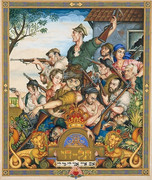Lod mosaic returns to Israel for exhibition
0 Comments Published by Avi Green on Monday, June 27, 2022 at 1:18 PM.
Some news on an Israeli mosaic from Lod that's been on display in foreign countries, and is now back from its tour:
During Roman rule, the city of Lod, also known as Lydda, flourished as the regional capital with a very diverse and cosmopolitan population, including Jews, pagans and early Christians. Sometime in the third century, a member of the wealthy elite, perhaps a merchant or political leader, commissioned the construction of a lavish villa in what was then the affluent quarter of the city, replete with floors made of the most impressive mosaics of its time.With any luck, I'll find the time to visit and check it out too.
The villa underwent various changes and renovations over the Roman, Byzantine and early Islamic periods, with rooms and mosaics added, walls taken down and put up, until apparently it all came tumbling down in an earthquake in 749 CE.
The mosaics were uncovered almost completely preserved 1,700 years later in 1996 during a rescue excavation led by late Antiquities Authority archaeologist Miriam Avissar prior to road construction work in an area adjacent to Ginton junction in the northeast of the city.
“It was the biggest and most impressive and unique mosaic discovered in Israel,” Mark Avrahami, head of the IAA Art Conservation Unit, said Monday at the dedication ceremony of the Shelby White and Leon Levy Lod Mosaic Archaeological Center.
The mosaic will go on public display at the center beginning this summer, following its exhibition worldwide since 2010, including at the New York Metropolitan Museum of Art.
Labels: Africa, Asia, Europe, Israel, Judaism, United States









0 Responses to “Lod mosaic returns to Israel for exhibition”
Post a Comment